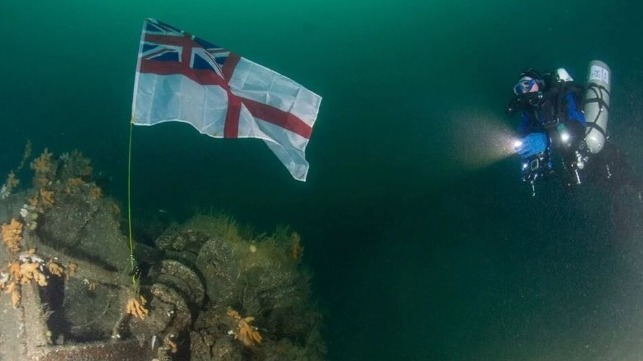Divers Raise the White Ensign Over Wreck of WWII Destroyer HMS Exmouth

The iconic Royal Navy flag will now fly on the wreckage of a World War II warship at its resting place on the seafloor after it was surveyed by divers for the first time.
The White Ensign, which has been flown on Royal Navy ships for centuries, has been placed on the wreck HMS Exmouth after more than 80 years, part of a plan to honor the lives of 190 crew lost with the ship.
The Exmouth was an E-class destroyer launched in 1934. The warship spent her early years in the Mediterranean carrying out operations connected with the Italian invasion of Abyssinia (today Ethiopia) and the Spanish Civil War. Her main tasks were enforcing the arms blockade imposed by Britain and France on both sides of the conflict.
At the start of WWII in September 1939, Exmouth found herself at the forefront. She was assigned escort duties accompanying major warships such as flagship HMS Hood on sorties or on convoy duties in home waters.
Five months into the war, the destroyer met her fate while escorting the steamer Cyprian Prince, ferrying supplies from Aberdeen to the Royal Navy’s wartime base at Scapa Flow in Orkney. The warship was targeted by the German submarine U-22, which launched a torpedo that struck her starboard bow and caused one of the forward ammunition magazines to explode. Historical accounts show that Exmouth sank within two minutes, with the loss of all 190 members of her crew. Only 18 bodies were later recovered ashore.
In 2001, divers on a private expedition discovered the wreck of Exmouth off the Scottish coast. Due to its depth and isolated location, the wreck has rarely been visited by underwater explorers.
The Royal Navy is now moving to ensure the wreck stays preserved and remembered, part of a wider project to preserve naval heritage and keep wartime sacrifices in the public memory. Divers plunged more than 50 meters into the depths of the North Sea some 20 miles off Wick, Scotland to conduct a comprehensive survey of the remains of the warship. Using the dive boat MV Clasina, the team sought to record Exmouth’s remains in detail while observing a strict ‘look, do not touch’ rule, since the wreck is a protected war grave.
The divers found that the bow of the wreck is almost non-existent, with only a single anchor and cable remaining. The engine room area is also heavily damaged, which was likely caused by the second explosion. The stern sits intact and upright, albeit at a right angle to the rest of the ship.
During the survey of the wreck, no artifacts were recovered, but a White Ensign was ‘raised’ over the Exmouth for the first time in more than 80 years.
“The Ensign just ‘fluttered’ there as if it was flying in the breeze,” said Lieutenant Commander Jen Smith. “I paused to pay my respects and it occurred to me that the last time a White Ensign would have been there was in January 1940; and that Ensign would never have been hauled down – it would have been in place as the ship sank. That was a really moving moment for me.”
No comments:
Post a Comment